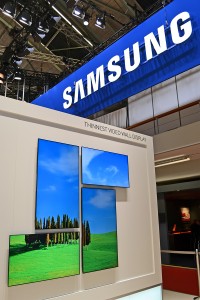Imitation, it is said, is the sincerest form of the flattery, and if this indeed the case, then Samsung is busy complementing Apple Inc. (NASDAQ:AAPL) practically nonstop. In a move that suggests it is not quite finished imitating its Cupertino rival’s every move, the Korean electronics manufacturer is once again showing an interest in sapphire crystal displays, after dismissing them a year ago due to excessive cost, according to a report from G for Games. The report draws on a Korean article describing essentially the same situation.
Sapphire, which is as clear as glass when manufactured without impurities, has considerable advantages over the current Gorilla Glass that Corning provides to most smartphone and tablet manufacturers. Sapphire displays are harder than steel, meaning they cannot be scratched by it. Smartphones with sapphire displays will presumably remain smooth and scratch-free until they are replaced, eliminating a major source of consumer dissatisfaction with touch screens.
 Sapphire has been too expensive to use for several years, but Apple and its ally GT Advanced Technologies (GTAT) have built a Mesa, Arizona facility that makes so much sapphire crystal it is likely to transform the market outright. Abundant sapphire will soon drive the price of this material down sharply and cause its widespread adoption in electronics manufacturing. Apple Inc. used its huge resources of cash to push the plant through rapidly and thus began what will likely be an important materials revolution of the early 21st century.
Sapphire has been too expensive to use for several years, but Apple and its ally GT Advanced Technologies (GTAT) have built a Mesa, Arizona facility that makes so much sapphire crystal it is likely to transform the market outright. Abundant sapphire will soon drive the price of this material down sharply and cause its widespread adoption in electronics manufacturing. Apple Inc. used its huge resources of cash to push the plant through rapidly and thus began what will likely be an important materials revolution of the early 21st century.
Intriguingly, each company now enjoys a comparative manufacturing advantage in a high tech material that its competitor desires intensely. Apple (AAPL) is far ahead in being able to manufacture commercially viable quantities of sapphire crystal, but Samsung is eager to join the Cupertino company in utilization of the substance. Samsung is closer to being able to produce marketable quantities of graphene, and has gained an advantage in patenting a large number of potential applications for the material, but Apple is maneuvering to catch up.
Some philosophers have posited that conflict is one of the important drivers of technological progress. There is some evidence to support this – the cataclysmic mayhem of the two World Wars drove rapid development of aircraft from slow-moving wood and cloth affairs driven by feeble propellers into aluminum-skinned jets, for example. Thankfully, Apple’s (AAPL) and Samsung’s competition is less bloody, but it appears that conflict may drive lightning fast development of two important material technologies from lab to factory.



